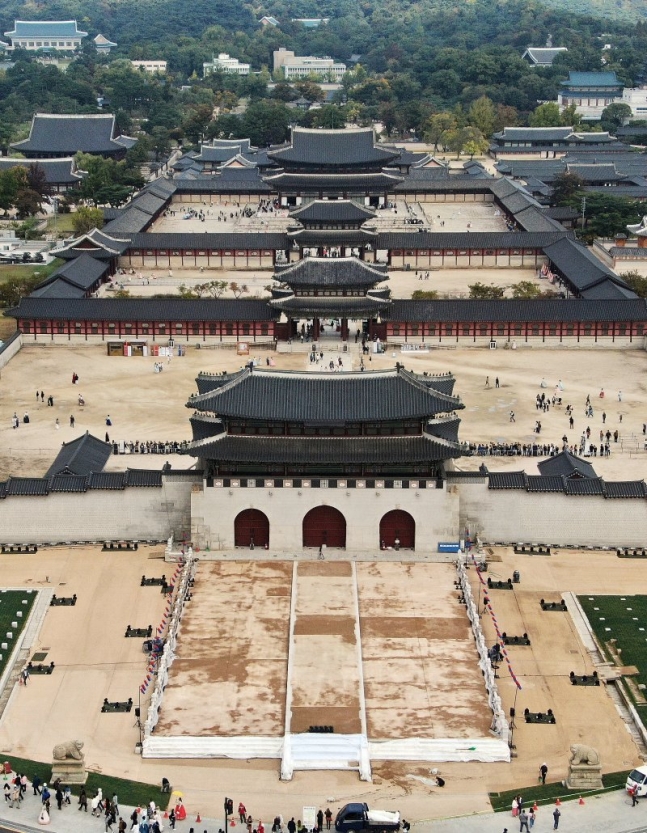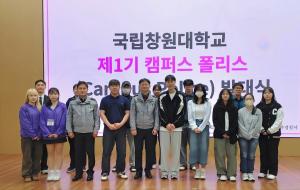 |
| ▲ Gwanghwamun Woldae construction site during the last cleanup of the restoration (Source: News1) |
On October 15, the Cultural Heritage Administration held an event at the plaza in front of Gwanghwamun at Gyeongbokgung to commemorate the restoration of the Gwanghwamun Woldae and signboard. After the pre- event, the main event held at 6 p.m., began with the lighting ceremony of the ‘Gwanghwa Light’ and the unveiling of the restored Woldae and signboard. After the event, government officials and 500 citizens who had applied in advance, entered Gyeongbokgung Palace through Gwanghwamun Gate and had time to relive the meaning of the completion of Gwanghwamun Gate. The Cultural Heritage Administration said that in preparation for this event, “it was prepared so that citizens could feel the meaning of Gwanghwamun’s, ‘spreading through light.’”
Woldae, built during the reign of King Gojong in 1866, was a place for diplomacy and communication with the people through royal events. According to 'The Veritable Records of King Sejong,' Woldae was also the place where the military exams were held, and a place where the people held Sang- eon (a system in which the people raised complaints by writing to the King), it served the function of raising the status of Gyeongbokgung. However, in the 1910s, when the Japanese Government- General of Korea promoted the Joseon Products Fair to publicize the legitimacy of colonial rule, a tram track was built in 1923, and Woldae lost its original appearance. The restoration of Gwanghwamun, which began in 2006, was conducted from September 2022 to April 2023 through intensive excavations by the Seoul National Research Institute of Cultural Heritage, which confirmed the ruined old site and the fact that there was a seven- meter royal road in the center. In addition, based on the results of research that found stones presumed to be part of the railing stones of Gwanghwamun Woldae, Woldae was restored using about 40 pieces. Two sculptures of Seo- Su (Mysterious animals in imagination), owned by the Samsung Group, were donated and placed at the front end of the royal road, and the Haitai statue, which was previously located next to Gwanghwamun, was moved to the front of Woldae to complete the restoration. The Cultural Heritage Administration said, “It is meaningful that Woldae completed the completion of the Gwanghwamun restoration project.”
The signboard, which was unveiled at the same time as the Woldae, was first restored in 1968 after being burned down along with the Gwanghwamun building during the Korean War. It was restored using the handwriting of Park Chung- hee, the president at the time, ignoring historical research. It was later restored for the second time in 2010 with black letters on a white background. However, the wooden surface cracked within three months, leading to controversy over poor restoration and criticism that it was a product made without proper historical research. In 2016, the representative of CARO revealed a photo of Gwanghwamun stored in the Smithsonian Museum in the United States, revealing that bright letters should be written on a black background. Later, in the ‘Gyeongbokgung Build Diary,’ which contains records of the reconstruction work of Gyeongbokgung, discovered at Waseda University in Japan, the color of the signboard was described as ‘gold letters on a black background’ and “the letters were made with copper plates and applied four pieces of the best gold,” was recorded. The current signboard, produced 13 years after the plan to create a new one, was written using the Chinese handwriting of Lim Tae- yeong, the training commander at the time of the reconstruction of Gyeongbokgung, and was produced by combining the evidence revealed previously.
The restoration of Gwanghwamun has deep historical significance because it was successfully restored to a level that is not much different from how it looked when it was rebuilt in the mid- 19th century. As the saying goes, “There is no future for a people who forgets history,” we must continue to pay attention to traditional cultural heritage in order not to forget history. Furthermore, it is hoped that projects to preserve and restore cultural heritage at a national level and to retrieve our cultural assets spread around the world will continue to be actively promoted.
By Kim Na-young, reporter skdud2986@naver.com
<저작권자 © The Campus Journal, 무단 전재 및 재배포 금지>

 Shrinkflation, Consumer Deception
Shrinkflation, Consumer Deception




